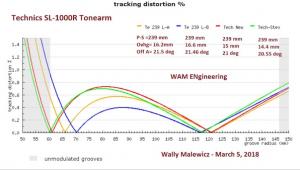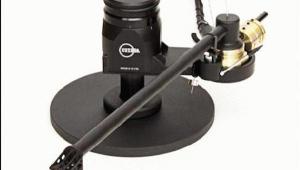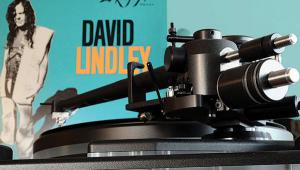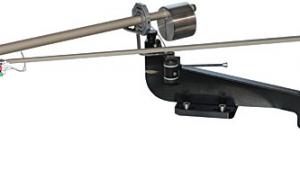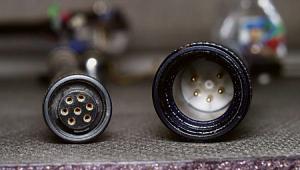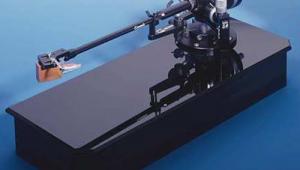Immedia RPM-2 tonearm Page 2
The back-end business comprises a complex, rather ingenious, decoupled stainless-steel counterweight and a threaded and keyed stainless-steel shaft assembly. The counterweight can be slid fore and aft on the shaft by turning the knurled stainless-steel nut situated directly behind it. The key keeps the counterweight, which is drilled off-center, from rotating on its axis as you adjust the tracking force. An interchangeable aluminum nut is also supplied for lighter cartridges.
But wait! There's more to this assembly—much more. The counterweight rides on a pair of rubber O-rings sandwiching a Delrin insert, thus is decoupled from the threaded shaft, which itself is decoupled horizontally from the stainless-steel bearing housing via an ingenious hinge-pin and rubber-sleeve device. This allows the counterweight assembly to pivot in a narrow horizontal arc.
In addition to setting the tracking force, the counterweight is used to adjust the arm's azimuth: because the shaft hole is drilled off-center, rotating the counterweight around its axis causes the weight to shift either left or right, thus changing the arm's lateral balance. Turning the screw heads that are accessible on either side of the counterweight shifts the weight in either direction in precise, repeatable increments.
Of course, as with every other arm save the Graham, which features outrigger weights offset at the same angle as its headshell, rotating the Immedia arm around its lateral axis does not compensate for the offset headshell. But at least here, unlike on the JMW Memorial arm, shifting the azimuth does not change VTF; nor does the angular deviation from the offset shift, depending on how far from perpendicular the correct azimuth setting turns out to be.
So what about VTA?
Unfortunately, with the RPM-2, you can't change VTA while a record is playing. However, the Immedia arm does solve a problem common to arms with adjustable VTA: as you change the VTA, you move the pivot point. But if the female part of the arm's bearing is fixed, how do you change the arm's height? The male part of the bearing is a polished tungsten pin set into a small stainless-steel hex-head screw riding tightly in a tapped hole set into the center of the main bearing housing. Turn the screw (accessible from the top) clockwise and the arm rises. Turn it counterclockwise and the arm descends. Because the housing is machined from a solid piece of stainless steel, only a small section of the screw is exposed beyond the end of the housing, thus maintaining structural stability. Another simple but ingenious mechanism (I'll spare you the details) keeps the screw tight.
Think about this: When you change VTA on the Immedia, while the back of the arm moves up and down relative to the stylus, the pivot point remains stationary. The Immedia RPM-2 is the only arm I know of that accomplishes this. Why is it significant? For one thing, it means that when you adjust azimuth, both the bearing pivot point and the stylus tip share the same point of rotation. Thus a lateral shift at the arm bearing results in a true lateral shift, not one that includes an unwanted vertical component. If you can conceptualize this, you'll understand its potential significance when using a "line contact"-type stylus. I wish I could draw.
Moreover, because the pivot point does not change with changes in VTA, and because you've set that point parallel to the stylus, you've minimized the effect of "warp wow"—the arm moving up and down in response to unflat records and, in effect, "traveling" forward and backward in time. The shortest distance between two points is a straight line. Deform the groove surface with a vertical warp and the stylus takes longer to get from point A to point B. The farther the pivot point is from parallel with the stylus, the greater the stylus's vertical arc when tracking a warped record, and thus the greater the "wow"—which is similar to what you hear when a stylus tracks a record pressed off-center.
And damping?
Damping is via synthetic motor oil (doesn't shift viscosity with normal room-temperature changes) packed in a fat syringe fitted with a needle, which allows you to "inject" fluid into the small space between the flared lower part of the bearing housing and the outer walls of the reservoir/arm base. More important, the needle also lets you easily suck fluid out, something you might need to do every time you lower VTA—doing so lowers the flat bottom of the housing, which contacts the oil.
This is one adjustment parameter in which Immedia has created a serious inconvenience—especially if you're the type who feels the need to adjust VTA with every thickness of record in your collection. Fortunately, with the markings on the syringe, you can calibrate how much fluid you have to add or subtract for each VTA setting.
You'll also have to check and probably readjust VTF when you change VTA—there is an interaction between the resistance caused by the oil in the reservoir and the tracking force. The lower the VTA, the lower the VTF. In one instance, lowering the arm caused the VTF to go from 1.8 to 1.5 grams. That changes the sound as much as changing the tracking angle.
I used Hi-Fi News & Record Review's new test record, imaginatively entitled Test Record (HFN 001), to help me determine the proper amount of damping fluid to put in the reservoir. This disc contains some extremely useful bands for determining both the horizontal and vertical resonances of the arm/cartridge combination you're setting up. The RPM-2 behaved ideally with all of the cartridges I used for this review, with both resonance points being at around 9Hz.
Antiskating
The RPM-2's anti-skating mechanism is a string-and-pivot lever/weight assembly. The string, attached to a set screw tapped into the stainless bearing housing centered below the armtube, passes through an eye guide and rides in a groove on the pivot housing, which is attached to the right side of the arm base. The string feeds through a hole in the housing, where it is held in place by a long, thin screw inserted into a tapped hole in the housing. A pair of circular weights riding on the screw thread allows you to adjust the amount of bias. Two set screws in the anti-skating mechanism permit you to adjust its height to keep the string's travel parallel with the record surface once you've set your VTA.
Now that's attention to detail. Of course, if you don't believe in anti-skating, you can easily remove the whole mechanism.
Overhang & final adjustments
The overhang jig is a mirror with a pattern etched onto its surface and a spindle hole cut into one corner. To set overhang you put the jig over the platter spindle and line up the armtube so that it's precisely parallel to and centered between the two long etched lines. That places a T etched into the surface right below the headshell area. Looking directly from the front, you line up the stylus so that it sits centered in the horizontal line of the T with the cantilever running down the vertical line—in effect, making it disappear. There: Both overhang and zenith are precisely locked in.
The second reflection from the mirror can lead to initial confusion, and getting the armtube properly situated between the two lines offers an uncomfortably subjective amount of latitude depending on where you line up your eyes. But with a bit of careful orientation, I found the system to be accurate when checked it against a Dennessen protractor.
Once you've locked down the cartridge and used the supplied Allen wrench to get the VTA approximately right, you set stylus force with the knurled knob and then, using the slotted screws set into the counterweight, you adjust azimuth however you do it: by eye, or by using the "out of phase" method to null crosstalk. The latter is what I use, and what Graham, Perkins, and many other manufacturers recommend as a starting point for those not fortunate enough to own a cartridge analyzer or a test record with modulations in only one groove (which you can use to minimize crosstalk from the other channel).
- Log in or register to post comments
